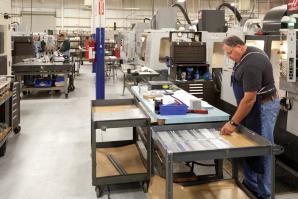When the president announced his federal stimulus plan, jurisdictions across the nation crossed their fingers for funding, and Placer County got in line. Because of forecasted population growth, Placer transportation agencies are trying to act fast to update and expand infrastructure, but the problem is available funding.
A cut of the federal funds landed locally, “but you could only use the money on projects that already had federal environmental clearance and were ready [for] construction,” says Celia McAdam, executive director of the Placer County Transportation Planning Agency.
Lead time and planning are crucial elements of any construction process, but the stimulus did not take that into account, she says. “What ended up happening is that we put most of the money into road rehabilitation — basic potholes and overlays.”
The planning agency would have preferred spending the money on big-picture projects such as the Lincoln Bypass and Interstate 80 interchanges — projects that are expensive, underfunded, crucial to the general plans of myriad jurisdictions, and, to the dismay of Placer County, only plodding along in their respective planning processes.
“It’s been challenging,” McAdam says. “The first round (of funding) came, and immediately you had to spend the money, and in a short time — six months — while jumping through significant hoops and requirements.”
Only one major project was ready and met the requirements for federal stimulus funding: the widening of Auburn Folsom Road. The stimulus dollars will fund phase three of the project this summer.
“Federal stimulus was a short-term shot in the arm. The feds wanted that money spent fast to create jobs with rehab and road projects,” says Mike McKeever, executive director of the Sacramento Area Council of Governments. “But it wasn’t nearly enough money to bring the system up to where it needs to be.”
And that’s just to meet today’s demand. Placer County’s population is expected to swell from 340,000 residents to more than 585,000 by 2035. The Sacramento Area Council of Governments has put forth its Metropolitan Transportation Plan to address the looming infrastructure needs that will affect Placer and its neighbors. But despite its efforts to spend more than $42 billion to improve regional infrastructure over the next three decades, road congestion is still expected to increase by 58 percent in the next 15 years, according to the organization.
“The reality is that, looking to the future, the transportation funding picture is not good,” McAdam says. “We are always working toward meeting our transportation needs, but there are some we don’t know how we will address.”
Placer’s list of unfunded construction projects totals nearly $3 billion. In addition, planners are concerned about public transportation, for which funding and needed infrastructure is sparse in Placer. The county has nearly $400 million in infrastructure projects under construction and is more than $50 million in the hole, struggling to fund priority assignments and wondering how it will accommodate the growing waiting list.
“There is a disconnect between what happens during the planning process and the funding realities. Most local agencies don’t verify that the improvements contained in their general plan are financially feasible,” says Ron Milam, principal in charge of technical development at Fehr & Peers. “If you look at Placer County and [its cities], their general plans are based on forecasting, but they need to ask if all the planned transportation improvements are something they can afford. The realization would be no — not without new funding mechanisms under the typical 20-year timeframe for a general plan.”
“The regular funding streams for roads, and particularly transit, are very much up in the air with big dark clouds.”
Mike McKeever, executive director, Sacramento Area Council of Governments
Placer Parkway is an example of the conflict between planning and funding. No cost and funding analysis was performed for the project when it was identified in the 1992 Placer County General Plan, nor was there an environmental plan. Eighteen years later, the county needs to move forward with the project and its $1.2 billion price tag, as estimated by SACOG. This includes a new 15-mile road connecting Highway 65 at Whitney Ranch Parkway to highways 70 and 99 in Sutter County. Just $10 million has been secured for the project through an adopted fee program. An additional $475 million in projected funding depends on future impact fees and development. It is also assumed that Sutter County will provide $100 million as its share of the project. The remaining funding is unresolved.
County officials have been working on developing new funding sources for years. They have come up with aggressive impact fee programs and might consider pursuing a transportation sales tax, similar to Sacramento’s Measure A, once the economy turns, according to McAdam. Not having such a program puts the county at a disadvantage in attracting matching funds.
County officials made an attempt at the ballot box in 2007, but it required a two-thirds majority and preliminary polling didn’t deliver the necessary numbers. The idea has been dormant since. The county could also consider a sales tax, parcel tax or Mello-Roos fee.
“Given the funding constraints that agencies face, we have started introducing financial constraints into the planning process early,” Milam says. “This helps agencies understand the important trade-offs associated with what they can afford to build and what compromises they need to consider in the event that funding shortfalls occur.
Milam says jurisdictions can’t just increase impact fees. There are market and political constraints that limit fee levels, even if nexus studies justify a higher amount. This is especially true when communities compete for new development because of sales tax revenue or job growth.
In the SACOG region, with the exception of El Dorado County, the impact fees charged to developers equate to less than the total actual costs to the jurisdictions. Assembly Bill 1600 allows jurisdictions to charge up to 100 percent of a development’s impact fees — the costs of planning, design, land purchase and road construction. In El Dorado County, impact fees are as high as $45,000 a unit, where in Roseville and Rocklin, impact fees are significantly less because those jurisdictions want to remain competitive.
The county’s primary concerns and priorities for future growth center on paying for road expansions, the widening of portions of Highway 65 and a slew of new interchanges for Interstate 80.
Officials expected developer impact fees to fund a number of those projects. However, because revenue from impact fees are based on projections, counties cannot secure loans against them, “so you have to wait for the development and impacts to occur before you can generate the money to make the necessary improvements,” McAdam says. “It would be wonderful to get out ahead of those needs now while prices are down and there is no development, but there is no income, so the timing is going to be mismatched.”
“If you look at Placer County and [its cities], their general plans are based on forecasting, but they need to ask if all the planned transportation improvements are something they can afford.” —Ron Milam, principal, Fehr & Peers
That can mean 10 or 15 years of growth and traffic congestion before enough money can be assessed and changes made.
“Placer County is in the middle of one of our major transportation connectors. In addition, South Placer is one of the largest economic nodes in the greater Sacramento region. Ensuring effective population growth is important,” says Ryan Sharp, director of the Center for Strategic Economic Research.
The county is acting quickly to maximize its purchasing power and capitalize on some of the recession’s benefits: decreased materials and construction costs and a massive pool of available labor.
“Because of the timing and the economy, we are able to make money go farther and move faster than we were anticipating,” McAdam says.
These projects include $61 million from a federal transportation bill passed in 2005 and an additional $10 million in federal earmarks. Combined with 2006 Proposition 1B funding — $4.5 billion for California highways — and other state and local funding, the county is working to resolve the Interstate 80 bottleneck between Placer and Sacramento counties.
“We’re going gangbusters. When we originally got the earmark, we thought the money would be enough to do phase two and half of phase three,” McAdam says. “As we got more creative and the economy changed, not only were we able to do all of phases two and three, but the savings was nearly $30 million. So the money can now go into a number of other projects in that corridor,” including reconstructing the Eureka Road interchange, preconstruction for the Rocklin Road interchange, adding an auxiliary lane to that location, and preconstruction for rehabbing the Highway 65 interchange, all along Interstate 80.
The $10 million in federal earmarks is also paying for a fraction of the $325 million Lincoln Bypass project, one of the county’s most pressing priorities. Phase one alone is estimated to cost about $300 million, McAdam says.
“That money has allowed us to keep moving along with the federal environmental documents, design, and agreements with Caltrans,” McAdam says. “Having the right money at the right time makes all the difference.”
Recommended For You

$30 Million Gamble
Port expansion project has uncertain future
The ports of West Sacramento and Stockton are betting that a $30 million public investment in new infrastructure will convince local importers and exporters to transfer their method of goods movement to the San Francisco Bay from trucking to barge shipping.

The Price of Progress
San Joaquin farmers protest bullet train
City dwellers driving past the expansive cotton fields and scattered farmhouses along Highway 43 to Corcoran might get the feeling they’ve left California. A haze of dust, bugs and little particles of cow dung blanket the road between Fresno and Bakersfield. Even on a nice day, wiping debris from a car windshield begins to feel futile.

The Auburn Advantage
How one city turned lifestyle into business leads
Downtown Auburn has a distinct, modern-day Mayberry feel, from the stone-paved sidewalks to the rustic brick bus stop. But five miles away,



